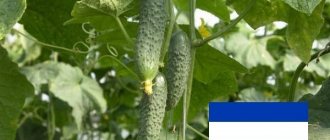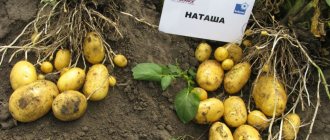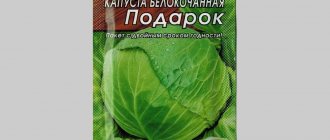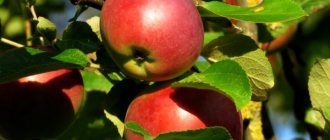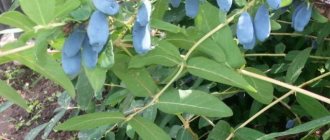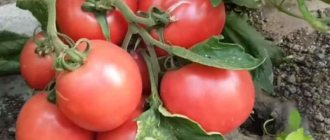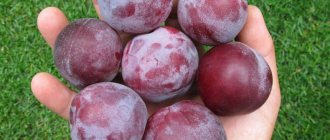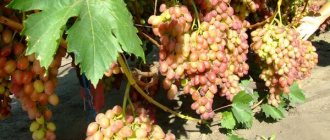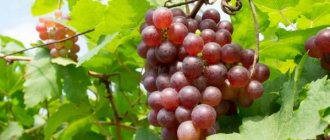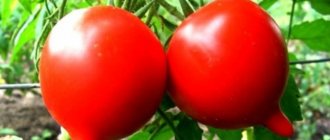Description of the variety
Corrado F1 (Carrodo) is a modern first-generation hybrid originally from the Netherlands, which was included in the State Register of Breeding Achievements in 2015 for cultivation in 6 regions of Russia. Despite the fact that the variety appeared relatively recently, it has already become a favorite among many gardeners. This is due to its properties, which are presented in the table below:
| Parameter | Description |
| Ripening period | Corrado is part of the group of early varieties. The harvest can be harvested 80-95 or 100-105 days after emergence. The timing may vary depending on the specific climate zone, since in the warmth the vegetable gains strength faster than in the cold. |
| Leaf Features | The plant develops hollow leaves, which are arranged in 2 rows - each subsequent row grows from the axil of the previous one. The leaves reach about 30 cm in length and are colored bluish-green. |
| Appearance of the bulbs | A vegetable with a powerful root system forms dense fruits with the following characteristics:
|
| Seeds | Sewing of this hybrid produces a large (up to 15 mm) hollow arrow, at the tip of which an inflorescence subsequently appears. At the end of the flowering phase, triangular black seeds are formed in the boxes. |
| Scope of application | Onions with a pleasant semi-sharp taste can be added fresh to salads, heat-treated when preparing various dishes, frozen and dried. |
| Productivity and germination | On average from 1 sq. m plot it is possible to collect about 8 kg of fruit. With winter sowings, up to 350 kg of harvest can be obtained from 1 acre, since the variety has high growth vigor and germination up to 96-100%. |
| Growth features | The hybrid has high immunity to various diseases, and also does not form arrows. It withstands temperature changes and is well adapted to various climatic conditions. It is medium primordial and suitable for cultivation. |
Onion set is the name of the planting material, and not the name of the onion variety. You can grow onion sets from any type of onion; you just need to leave the onion arrow until a box with seeds (the so-called nigella) appears, which should be collected and planted. From each nigella will grow an onion set, and from each set a full-fledged onion head.
Features of the Corrado variety
Onions of this variety are a modern hybrid plant that can be grown in different regions of the Russian Federation. The variety is sometimes mistakenly called Korady. However, its name is actually pronounced Corrado.
Description, origin and development
The plant is a new hybrid, which was bred by the Dutch company NICKERSON ZWAAN BV. The culture was included in the State Register of Russia in 2015.
Onions of this variety have excellent yield
The plant can be planted in 6 regions - in the Central Black Earth, the North Caucasus and the Far East. It can also be planted in Western and Eastern Siberia and the Lower Volga region.
For reference! The hybrid is considered early ripening - some experts claim that the harvest can be harvested 95–98 days after emergence.
Onion sets Corrado F 1 should be planted as a two-year crop: the seeds are planted in the first year, and then the sets.
Characteristics of onions and yield
The bulbs of this variety have a rounded-flat shape. It is covered with a dense husk of a golden hue. The peel covers the internal scales well, which increases the shelf life of the onion and its commercial characteristics.
The leaves are hollow and have a two-row arrangement. Each subsequent leaf appears from the bosom of the previous one. The length of the feathers reaches 30 cm. They have a bluish-green tint.
The description of the Corrado onion variety says that if the plant is planted with seeds, it produces a long arrow measuring 1.5 m. An inflorescence forms at its end. After flowering is completed, black seeds appear in the boxes.
Onions are characterized by high yield parameters. From 1 square meter you can get approximately 8 kg of vegetables. When planting winter onions, it is possible to harvest 350 kg from one hundred square meters.
With proper care, onions are characterized by high yields.
Landing dates
They can be determined depending on the region where the vegetable is grown:
- southern and central regions - onions can be planted for the winter in October-November, when the temperature warms up to +5°C (the crop will overwinter well, and with the onset of warmth it will bear fruitful shoots);
- north - planting should begin in the spring, when the weather warms up to +10...+12°C.
The optimal temperature for ripening onions is from +18 to 20°C. In warmer conditions and with a lack of moisture, the taste of the vegetable will deteriorate. If its ripening occurs at temperatures below +18°C, the bulbs will be stunted in growth and shortened in size.
The crop can be grown in open ground. A greenhouse is useful only if you need to harvest greenery throughout the spring and autumn period.
How to make your own seedlings
The first stage of propagating seedlings is to prepare the seeds. It was said earlier that when purchasing seeds, they should be checked for germination. If this rule has been followed, then you need to start preparing the seeds a few days before sowing. If the seeds for seedlings have not been previously tested, then you need at least another 14 days, as there is a risk that the seeds will not meet the declared quality. In this case, the seeds will have to be replaced.
The tested seed material needs to be warmed up a little. To do this, add water at a temperature of 50 ° C to a medium-sized container. The seeds should be immersed there for about half an hour. After this, they need to be kept under running water for several minutes. You should check every day to see if the seeds have sprouted. When the sprouts are clearly visible on 5% of the seeds, this will indicate that the time has come to plant the material in the soil.
Processing of planting material
To grow Corrado, you can use onion sets or seeds. In any case, when preparing it, you need to take into account a number of rules, which we will consider below.
Onion sets
Classified by size and suitable for planting at different times:
| Fraction | Dimensions | Landing dates |
| Small | 8-14 mm | Ideal for winter planting. |
| Average | 14-21 mm | Suitable for winter and spring planting. |
| Above average | 21-24 mm | When planted in winter, it will produce a feather, and when planted in spring, it will produce a rich harvest of heads, but subject to favorable planting dates. |
| Large | 24-30 mm | It has the same planting time as 21-24 mm sets, but the cost is lower. |
| Sample | 30-40 mm | Used for planting on greens. |
Bulbs of any fraction should not be purchased outside, especially in cold weather. Such planting material is most likely frozen, so its germination will be spoiled. In addition, you need to pay attention to the fact that the sets have the following characteristics:
- have a smooth surface free of any defects;
- are dry (without excess moisture);
- have a dense structure.
If the product is in original packaging, it must indicate the packaging date and expiration date.
Any seedlings must be properly stored in a ventilated area at a temperature of +10...+15°C and a humidity of 70-75%. It is important to avoid shock changes in the microclimate, otherwise this will lead to the appearance of arrows on them.
Seeds
You need to buy them from a trusted store, giving preference to well-known manufacturers. You must check the expiration date of the product on the label. After purchase, it is advisable to check the germination of seeds by following the following guidelines:
- Take 10-15 grains and place them in a glass or container for seedlings with a volume of 50-100 ml. Cover its bottom with filter paper or gauze.
- Pour water over the seeds until they are slightly wet.
- Remove the container to a warm place and leave for 7-10 days.
- After the specified time has passed, count the number of hatched seeds. There should be at least half of the total number of soaked grains (germination rate of at least 50%).
How to grow Corrado onions
To successfully grow a crop, you need to purchase high-quality planting material, prepare the site and follow the planting technology.
Preparatory work before landing
Corrado onions do not make any special demands on the quality and composition of the soil. High yields are obtained if it is planted in loose, well-drained, loamy soil with a neutral pH level. If the soil is too acidic, it is necessary to add lime 2 years before planting the onions. It is advisable to feed the area with organic matter - humus. It also needs to be added for digging, but not earlier than 1.5 years before placing the seeds in the ground.
It is better to prepare high, warm beds for planting.
Selecting a location
When choosing a place for planting, it is important to follow the rules of crop rotation. According to them, it is better to plant onions where legumes, tomatoes, cabbage, and potatoes previously grew. The worst predecessors for it are all types of onions, garlic, carrots, and cucumbers. The plant can be grown in the same place for 2 years in a row. Then it is allowed to be planted in the same bed only after 5 years.
The area where it is planned to equip onion beds should be well lit and sheltered from drafts.
It is useful to read that next year you can plant after onions.
Seed preparation
Most often, Corrado onions are planted from sets. When purchasing, you should evaluate its appearance. The heads must be free of defects such as stains, cracks, and damage. Only dense and dry bulbs are suitable for planting.
Storage of your own seeds should take place under certain conditions: at a temperature of +10...+15°C and a humidity of 70–75%. For planting, specimens 1 cm in diameter are selected.
When purchasing packaged sets, you need to pay attention to the expiration date.
If you prefer sowing seeds, then you need to choose those that are packaged by well-known manufacturers. Before planting, it is advisable to check them for germination. To do this, place 10–15 seeds in a small amount of water and send them to a room where a warm temperature is maintained. The seeds are considered good if more than half of them have sprouted.
Soil selection and preparation
For the bow, you need to select an area with the following characteristics:
- located on a slight hill;
- protected from cold winds and drafts;
- warms up well under the sun's rays.
Hydride grows well on all types of soil, but prefers loose soils and loams with neutral acidity more than others. If necessary, it can be lowered with lime, but it is advisable to do this 2-3 years before sowing onions. The soil can also be fed with humus in advance (1.5-2 years in advance).
The rules of crop rotation cannot be ignored. It is best to plant onions after early varieties of cabbage, cucumbers, zucchini and potatoes. The crop can be returned to the same place only after 3 years. It is also undesirable to grow it after legumes (peas, beans).
Experienced gardeners grow onions next to carrots, as these crops complement each other perfectly and prevent the appearance of harmful insects. In order to repel onion flour, you can plant calendula and marigolds around the perimeter of the bed.
The marked area must be properly prepared. The specific list of actions depends on the planting method:
- Autumn . The soil needs to be mulched with leaves, peat and humus, forming a layer of 8-10 cm. This will protect it from freezing. 14 days before the arrival of cold weather, remove the mulch and plant seedlings in the ground, which should be mulched on top again.
- Spring . Remove the mulch prepared in the fall, loosen the soil with a rake and make grooves in it for sowing bulbs.
Preparing the beds and soil
To successfully grow the Corrado variety, you need fertile, light, airy soil, for example, loam or sandy loam. A neutral acidity level is required. The garden area for planting onions should be well lit by the sun. Ideal predecessors are:
- tomatoes;
- potato;
- greenery;
- beans;
- pumpkin;
- zucchini.
To prepare the land in the fall, apply one of the fertilizers per 1 m² during digging:
- Mineral supplements: 15 g of potassium sulfate along with 20 g of superphosphate.
- Folk remedies: 2 cups of ash solution and up to 8 kg of humus or compost.
Important! There is no need to lime the soil!
If planting is planned for spring, and the soil was not prepared in the fall, then you can fertilize it immediately before planting the seedlings under one of the diagrams below (proportions are given per 1 m²):
- 60 grams of nitrophoska.
- 20 g of urea along with 5 g of potassium sulfate and 7 g of superphosphate.
Planting Corrado onion sets in the ground
A popular technology that can be roughly divided into two stages.
Treatment
Start it about a month before planting:
- Sort through the bulbs - discard dried and damaged specimens, and sort the remaining ones by size.
- Dry the sevok in a warm and dry place without drafts, and then warm it up so that it does not shoot out prematurely. This can be done near a heating radiator or in natural conditions (under the sun's rays). Keep the bulbs at a temperature of +20°C for 14 days, and then place them in conditions with a temperature of +40°C for 8-10 hours.
- Before planting, disinfect the bulbs - immerse them in a solution of copper sulfate (30 g per 10 liters of water) for 2 hours and rinse under warm running water.
Landing in the ground
The seedlings need to be planted in beds, into which furrows should be made in advance. The landing pattern is as follows:
- width between holes – 8-10 cm;
- distance between rows – 20-30 cm;
- planting depth is 3-4 cm for spring planting and 6-10 for winter planting.
The bulbs should not be soaked before planting. They need to be planted in ready-made furrows so that the neck is 1.5-2 cm below the ground level.
Seed planting process
It is quite possible to propagate onions by seed. In this case, you need to properly prepare the planting material.
Seed preparation
After purchase, it is important to immediately evaluate the germination of seed material. In this case, proceed as follows:
- Take 10-15 grains and place them in a container for seedlings. Place gauze on the bottom.
- Lightly moisten the seeds with water.
- Place the container in a warm place for 7-10 days.
- Count the number of hatched seeds. Their number should be at least 50%.
High-quality planting material should be prepared as follows:
- Take warm water into a small container - its temperature should be 50 degrees.
- Place the seeds in a container for half an hour.
- Keep the heated grains under running water for 2-3 minutes.
- If necessary, soak the planting material for a day in a solution of potassium permanganate and place it in Ecopin for 3 hours.
- Wrap the seeds in a damp cloth and place in a warm place.
- Check the sprouts every day.
- When 3-5% of the seeds hatch, they can be planted in the ground.
Seedling cultivation method
This technology allows you to get not only an earlier harvest, but also a more viable one. Its implementation can be divided into several stages, each of which will be considered separately.
Seed treatment
The first step is to test the seeds for germination using the technology described above. If this rule is followed, then processing of the seed should begin 2-3 days before sowing. If this step was skipped, then it will take about 14 days, since it is possible that the seeds do not meet the declared quality and will have to be replaced.
Tested seeds should be processed as follows:
- Fill a small container with warm (50°C) water and immerse the seeds in it for 20-30 minutes.
- Cool the heated material slightly - hold it under running water for 2-3 minutes.
- If necessary, disinfect the seeds yourself - soak them for a day in a weak solution of potassium permanganate and dip them in a growth stimulator, for example Ecopin, for about 3 hours.
- Wrap the seeds in a damp cloth and transfer to a warm place. Every day they need to be checked for germination. When 3-5% of the seeds sprout, they should be planted in the soil.
Sowing
Seedlings can be grown in boxes or cups that are no more than 6-9 cm deep and have drainage holes at the bottom. As soil, you can use a purchased substrate or a self-prepared mixture of the following components:
- leaf soil (1);
- turf (1);
- humus (1.5);
- river sand (0.5).
You need to fill the containers for seedlings with the prepared composition and approximately 50-60 days before transplanting the seedlings into open ground (in April-May), begin sowing the seeds, adhering to the following order:
- Using tweezers, carefully place each seed into small grooves at a distance of 1.5 cm from each other.
- Sprinkle the seeds on top with soil and cover with film.
Growing seedlings
To get strong seedlings, you need to properly care for them, observing the following measures:
- Creating an optimal microclimate . After sowing, transfer the seedlings to a warm place and keep them indoors at a temperature of +18...+25°C until the first shoots appear. Next, lower it to +14...+16°C and remove the film, and move the boxes to a sunny place. Thanks to these manipulations, the seedlings will not stretch.
- Watering . As a crust appears on the top layer of soil, moisten the soil with settled water at room temperature. At the same time, you should not flood the soil, otherwise the roots will become rotten.
- Feeding . At intervals of 14 days, feed the seedlings with a solution of 20 g of superphosphate, 5 g of potassium chloride and 10 g of urea per 10 liters of water. A simpler feeding option is chicken manure diluted in water (1:10).
- Hardening . 2 weeks before planting, take the seedlings out into the open air. The time of the first procedure is no more than 10-15 minutes. Every day its duration must be gradually increased.
Transplants into the ground
As soon as frost has passed, seedlings with 3-4 true leaves can be transplanted to a permanent location. It is better to do this in the afternoon. The substrate with seedlings must be moistened, each seedling must be taken out and the roots that are too long must be shortened by a third. Planting should be done according to the following scheme:
- width between holes – 5 cm;
- distance between rows – 30 cm;
- embedment depth – 1 cm.
After planting, water the bed well and mulch (for example, peat).
Recommendations for agricultural technology
Planting material "Corrado F1" is offered by various foreign and domestic companies, but it is produced on an industrial scale in the Netherlands. The main advantages of the original set are that it does not require pre-treatment, has fast and massive germination, and practically does not shoot, which ensures high marketable yield. When growing F1 hybrids, attempts to collect seeds and sow them in open ground or for seedlings do not make sense, since the plants show all their improved qualities only in the first generation. For many Russian vegetable growers, the only drawback of Dutch onions is the cost of planting material, which must be purchased annually.
For planting in small areas, Corrado F1 onion sets can be purchased in convenient packaging of 0.5-1 kg
Sevok is planted before winter or in spring. Spring planting is carried out in late April - early May, while the ground is still wet from melted snow, and the average daily air temperature is consistently above +5 ℃, that is, during the day about 10-12 degrees Celsius, and at night not lower than 2-5. Small seedlings are planted first, and larger bulbs a little later. Shoots appear on the 9-12th day.
A high yield of marketable products is ensured during winter planting in October - November, after the first frosts on the soil. At the same time, in the next season the first fresh greens grow 1-1.5 months earlier than onions planted in the spring. As practice shows, it is better not to rush and even delay the timing of planting work a little, so that the winter seedlings do not have time to start growing. And so that it overwinters well and does not freeze out in regions with harsh snowless winters, the beds can be covered with a mulch layer or non-woven material.
The bulbs are planted to a depth of no more than 5 cm and not too densely, at a distance of 6-7 cm from each other and 15 cm between the grooves
When forcing green feathers from sowing and sampling, in comparison with the seed method, the nutritional properties of the leaves are significantly improved, the content of vitamins and plant phytoncides increases.
Onion care is standard. Irrigation in dry weather during the initial stages of growth, weeding, thinning (in case of dense planting) and loosening of the beds is considered mandatory, preventing the formation of a crust on the soil, which interferes with the flow of air to the roots. The plant responds gratefully to the application of mineral and organic fertilizers.
Mineral fertilizing is carried out with complex fertilizers dissolved in water, or scattered over the surface of the soil and watered abundantly.
The obvious advantages of Corrado onions include ease of care and resistance to unfavorable growing conditions. Seedlings easily tolerate short-term cold snaps. Plants are practically not affected by pests and are little susceptible to downy mildew.
Planting care
Regardless of the planting method, vegetation must be properly cared for. Let's look at what needs to be done for this in detail.
Watering
After sowing, the crop should be watered immediately and then moistened for 2 months with a frequency of 1-2 times a week. It is worth making adjustments to this scheme based on specific weather conditions. For example, in the dry season, the frequency of watering needs to be increased, otherwise glycosides will accumulate in the bulbs, which will give them bitterness. In any case, for this procedure you must use settled water at room temperature.
By the middle of the growing season, the frequency of watering should be reduced, and 2-3 weeks before harvesting, it should be stopped altogether.
Loosening and weeding
In order for a vegetable crop to develop normally, weeds must be removed from the garden bed approximately once a week. This procedure should be carried out in the evening or in the morning (before the heat sets in) in dry weather. Along with weeding, you need to perform shallow loosening of the soil. In this case, there is no need to hill the onion.
Top dressing
With proper preparatory measures during the growing season, the crop will not need additional fertilizer. However, it can give signals indicating the need for feeding:
- If the vegetable is stunted and yellowness appears on the leaves, it means there is not enough nutrients in the soil. To correct the situation, it is worth adding a nutrient mixture of 10 g of ammonium nitrate and 15 g of potassium salt per 1 bucket of water to the ground. This composition is enough to process 1 square. m beds.
- If the greenery becomes dull, this indicates a lack of nitrogen in the soil. To stabilize it, the soil must be watered with a urea solution (10-15 g per 10 liters of water).
- If the feathers curl, it means there is a lack of potassium. It can be replenished by adding a solution of potassium salt (5-7 g per 5 liters of water).
Growing methods
To plant Corrado onions, it is necessary to choose a site on a small hill that will not be sheltered from intense exposure to sunlight and protected from the wind, which has a very negative effect on the process of crop maturation. Gardeners living in the southern regions and in the middle zone of our vast homeland can begin planting for the winter in October or November. Residents of more northern regions are recommended to start planting in the spring, when the soil warms up to 10 degrees. The most suitable temperature for ripening this crop is considered to be 18–20 °C. When exposed to extremely high temperatures and lack of moisture, the taste of Corrado onions is distorted, and if it ripens in cold conditions, the bulbs will not grow in size.
Harvest and storage
There are a number of signs that will help determine a ripe crop. It looks like this:
- the leaves turned yellow and fell to the ground;
- the formation of new leaves has stopped;
- the onion neck has become thinner and softened;
- the bulbs were covered with dry scales.
If such signs are observed, harvesting should begin in dry weather. This must be done manually, carefully pulling the bulbs out of the soil, holding them by the tops.
The collected onions need to be shaken off the ground and left in the garden so that they dry out a little. This will take about 2-3 days. If the weather is cloudy or rainy, you will have to dry the onions under a shed or in the attic, but this procedure will take at least 1-2 weeks. During this time, the crop should be regularly inspected and turned over. It is not recommended to trim the tails - this can lead to rotting of the bulbs.
Dried onions should be stored in wooden boxes and kept in a well-ventilated area at a temperature of +15...+20°C. If all storage rules are followed, onions will retain their presentation and taste until the next harvest.
Advantages and disadvantages
The new hybrid onion Corrado has its own advantages, thanks to which it may appeal to many vegetable growers:
- can be planted both in autumn and spring;
- resistant to shooting;
- characterized by relative early ripeness;
- forms large heads;
- has good productivity;
- excellent ripening of bulbs placed for ripening;
- Suitable for lovers of semi-sharp taste.
- suitable for storage.
This new Dutch hybrid has no disadvantages, except that it needs to be grown from sets, which, by the way, are not so cheap. But the high cost of seed material is typical for many new varieties of crops, so it cannot be considered a disadvantage of this particular hybrid.
Pros and cons of a hybrid
The Dutch variety is revered by gardeners for the following qualities:
- high yield rates (with a good wintering, 350 kg of fruit can be collected per hundred square meters);
- resistance to shooting;
- good immunity to various pathogenic microorganisms;
- strong root system;
- almost 100% germination rate;
- excellent keeping quality.
Corrado onions
As for the weaknesses of this vegetable, we can note its low adaptation to low temperatures. For this reason, it is best grown in the southern and middle regions rather than in the north.
Description and characteristics
Corrado F1 onion is an early variety, a first generation hybrid.
In appearance it is:
- the plant itself is powerful, spreading, with fleshy leaves with a slight waxy coating;
- the heads are round, large, bichaginate;
- thin neck of bulbs;
- internal scales are white, with a greenish tint;
- outer scales are golden brown, slightly greyish.
Unique Features:
- large heads;
- good keeping quality and presentation;
- versatility of use in cooking;
- Both winter and spring plantings are allowed;
- good ripening of bulbs;
- not subject to shooting.
It has a pleasant, semi-sharp taste, which makes Corrado onions versatile. It is used in all kinds of dishes (soups, salads, side dishes), this onion can be dried and frozen along with mid-season varieties, although it is early.
Reviews about the variety
★★★★★
Margarita Ivanovna, 59 years old. I grew a set of this hybrid this year.
The harvest was good, although I didn’t put in much effort. The bulbs turned out beautiful, uniform and dense. The variety did not disappoint. ★★★★★
Anna Sergeevna, 37 years old. I wasn't particularly impressed with Corrado's bow.
The bulbs grew moderately large and uniform, but their taste seemed too weakly expressed. Here, as they say, it’s not for everyone. ★★★★★
Dmitry Stepanovich, 45 years old. I bought a hybrid only because it is suitable for winter planting.
I wanted to get an early harvest, which I managed to do. I planted the seedlings in the fall, and in the spring I harvested a healthy harvest of golden bulbs. The agricultural technology is standard, I didn’t even have to feed it. I recommend to everyone. Hide
Add your review
Popular types of onions include the hybrid Corrado F1. Gardeners have taken a closer look at it for its unpretentiousness to external conditions, rapid germination, high yield and good taste.
0
0
Copy link
Reviews
Gardeners love the taste and attractive presentation of the bulbs. The hybrid is easy to care for and the harvest is stored for a long time.
Yaroslav, Orel: “The Corrado hybrid was attracted by the fact that it is planted before winter. I didn’t take much care of the crop when growing it, but I got a big harvest.”
Daria, Kostroma: “Last year I studied the descriptions of hybrids, varieties, reviews about them - the Corrado onion attracted my attention. I planted it and was pleased with the result. The bulbs are smooth and dense, not too spicy in taste. I fed the vegetables with chicken manure.”
Kirill, Uralsk : “I liked Corrado. It has a large harvest, is easy to grow, and has a high shelf life. However, sometimes feathers begin to dry out. I solve the problem with additional watering and fertilizing.”
Growing conditions
For an onion bed on your site, you should choose a place on a small hill, well lit by the sun and sheltered from cold winds. Culture does not like drafts. Southerners and residents of the temperate zone can plant the Corrado variety for the winter in October-November, when the soil temperature reaches 5 °C. Summer residents of colder latitudes should wait until spring, when the temperature overcomes the barrier of 10–12 °C. The optimal temperature for ripening onions is 18–20 °C. At higher temperatures and lack of moisture, taste deteriorates, and at low temperatures, growth slows down.
Agrotechnics of cultivation and care
Light, loose, fertile soils are suitable for cultivating Corrado F1 onions: sandy loam or loam. The beds for the crop are prepared in the fall. Choose well-lit areas of the garden where cucumbers, early potatoes and cabbage, zucchini, and pumpkins previously grew. Good predecessors of onions are also tomatoes, beans and herbs.
When digging up the soil, add 5-8 kg of rotted compost or humus and 2 cups of ash per 1 m2. When using mineral fertilizers, instead of the last component, add 20 g of superphosphate and 15 g of potassium sulfate. Liming is not carried out. If such a procedure is necessary, it is performed a year before planting, that is, for predecessor crops.
The seedlings are planted before winter. Depending on the region, this could be October or November, when the temperature drops to + 5 °C. The timing of such work coincides with the planting of winter garlic. Corrado onion sets are planted according to the following scheme: 5-10 cm between sets in a row and 20 cm between rows.
Planting material is preliminarily inspected. Only absolutely healthy bulbs are selected, without visible signs of disease or mechanical damage. They should not have sprouted roots or feathers. The sets are not soaked and are not stimulated to grow. When planting in winter, this can lead to the death of the bulbs. Seeds purchased from a reliable manufacturer have already been treated with fungicides, so there is no point in treating them either.
In order for the bulbs to survive the winter well, they are planted deep into the ground 4-6 cm above the root collars. The furrows are filled with peat or fertile soil. The beds must be mulched. In winter, in addition, a thick layer of snow, which is thrown over the beds, helps protect the plantings from freezing.
Pre-winter planting is an opportunity to get a harvest of Corrado F1 onions earlier than with spring planting. At the same time, commercial heads are distinguished by excellent keeping quality, juiciness and delicate taste.
You can plant Corrado sets in the spring. Planting material is heated near heating radiators a few days before, and if desired, soaked in growth stimulants. Work begins at a temperature of at least 12 °C so that the plants do not start to shoot.
If the beds have not been prepared since the fall, complex fertilizers are applied to the onions in the spring, in particular Nitrophoska - 60 g per m2. An additional 20 g of urea and 1/3 of the dose of autumn phosphorus-potassium preparations are added to the amended soil. Sevok is planted according to the same scheme as before winter. The difference is that now a layer of soil of 2-3 cm is left above the neck of the bulbs.
Further care for obtaining Corrado onion turnips consists of standard operations. Plantings need watering, loosening row spacing, and weeding. Irrigation is carried out 1-2 times a week, but the irrigation regime may vary slightly depending on the growing region and weather conditions. In hot, dry weather and on light sandy soils, water onions more often and in larger quantities. They completely stop irrigating the plantings 2-3 weeks before harvesting the turnips.
Feed Corrado onions 3 times per season. For the first time, predominantly nitrogen fertilizers are used. They are most needed by plants at this stage to increase green mass. Fertilize the beds 2 weeks after the seed germination.
Apply the following compositions by dissolving fertilizers in a bucket of water:
- 1 tbsp. l. urea + 1 glass of slurry;
- 1 tbsp. l. urea + 2 tbsp. l. "Vegata."
The next feeding is carried out after another 3-4 weeks. Apply:
- 2 tbsp. l. nitrophoska;
- 20 ml “Agricola-2” per 1 liter of water or 20 g of the drug in granules per bucket;
- 10-15 g of Crystal.
For the third feeding during the period when the bulbs begin to form, the following fertilizers are used:
- 1 glass of ash;
- 10 g potassium sulfate + 20 g superphosphate.
Fertilizers are also dissolved in a bucket of water. Each application is combined with watering the plants.
The harvest is harvested approximately 3 months after the seed germination. Winter-planted onions ripen 2-3 weeks faster than those planted in the spring. They dig it up in dry weather, when the leaves turn yellow, droop to the ground, or dry out. The plants, along with the tops, are left in the garden bed to dry, and then cut 4-6 cm above the neck. If the weather does not allow this, the crop is transferred under sheds, into sheds, into attics and ripened there. Store onions after harvesting in ventilated areas at a temperature of 2-3 °C or 16-18 °C, humidity up to 80%.
Growing from seedlings in open ground
This method of planting crops is more familiar to us. But it also has its own characteristics.
Site selection and soil preparation
As mentioned earlier, the Corrado onion loves nutritious, loose, loamy soil and prefers to grow on a hill, in a place sheltered from the winds. Usually the seedlings are planted in open ground. Greenhouses are used only when it is necessary to obtain greenery throughout the spring-autumn period. If autumn planting is planned, then the soil must first be mulched with leaves, peat and humus, forming a layer of 8–10 cm.
This will protect the soil from freezing. About 2 weeks before the onset of cold weather, the mulch is removed and seedlings are planted in the soil. The top of the soil needs to be mulched again. When planting in spring, the mulch laid out in the fall is raked, the soil is loosened with a rake and furrows are made. Onions are planted in them and covered with special material.
Preparing the sets
About 1 month before the intended planting of the crop, the planting material must be sorted out. It is sorted by size, spoiled, dried, injured onions are removed. The finished material undergoes a drying procedure in a warm, dry room without drafts. The dried seedlings must be warmed up so that they do not shoot prematurely. You can heat it under a radiator or under the sun's rays.
The process of planting seedlings in the ground
The seedling is planted in beds in which grooves have been made in advance. The depth of the furrow should correspond to the size of the seed. If the diameter of the bulb is 1 cm, then the depth of the furrow should be about 4 cm. The furrows must be made at a distance of 20–30 cm from one another. The bulb is buried 3–5 cm into the soil. There should be 5–10 cm between the sets.
The first abundant watering should be carried out immediately after planting the crop. Then, for about 2 months, you should moisten the crops 1-2 times a week. It is better to water with settled water at room temperature. If the dry season has arrived, the frequency of watering should be increased. Adjust the interval yourself, based on the condition of the soil. Somewhere in the middle of the growing season, the frequency of watering is gradually reduced. Watering is stopped 2-3 weeks before harvesting.
Loosening the soil and weeding
Loosening the soil is done while removing weeds. And weeds should be removed regularly (once a week), otherwise they will interfere with the normal development of the crop. There is no need to hill up the onions while loosening the soil. The procedure should be carried out in the evening or morning (before the onset of heat) in dry weather.
If the soil is properly prepared, fertilizing may not be necessary. But if you notice a disturbance in the growth of the crop, the appearance of yellowness on the foliage, then it is necessary to add nutrient mixtures to the ground. The easiest way is to prepare a mixture of ammonium nitrate (10 g) and potassium salt (15 g) and dissolve it in 1 bucket of water. This will be enough to feed 1 square. m beds. You can also add ash.
Pests, diseases and prevention
The variety is resistant to diseases and pests. Therefore, if you follow all the rules of cultivation, the crop will delight you with a good harvest.
Harvest and storage
The growing season of Corrado onions is 93–105 days. After this period of time, counted from germination, the harvest can be harvested. The ripening of onions will be indicated by:
- cessation of new leaf growth;
- leaves falling to the ground and gradually dying off (yellowing);
- thinning and softening of the onion neck.
Harvest by hand in dry weather. Each bulb is carefully removed from the soil by the tops, shaken off the ground and left on the site. The harvested crop should dry out a little. This will take several days. If rain is expected, it is recommended to move the crop to the attic or shed for drying. Under the same conditions, the crop is dried after the field.
During the drying process, the onions must be turned over and mixed. Drying time is 1–2 weeks. The harvest is stored in a ventilated room at a temperature of 15–20 ° C in wooden boxes. If storage conditions are met, onions of this variety can last until a new harvest, retaining all their properties.
